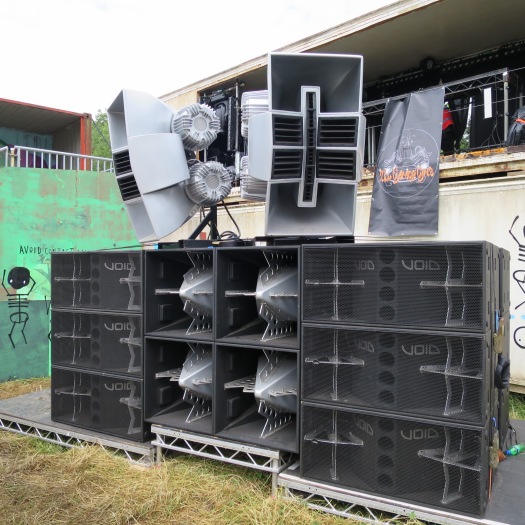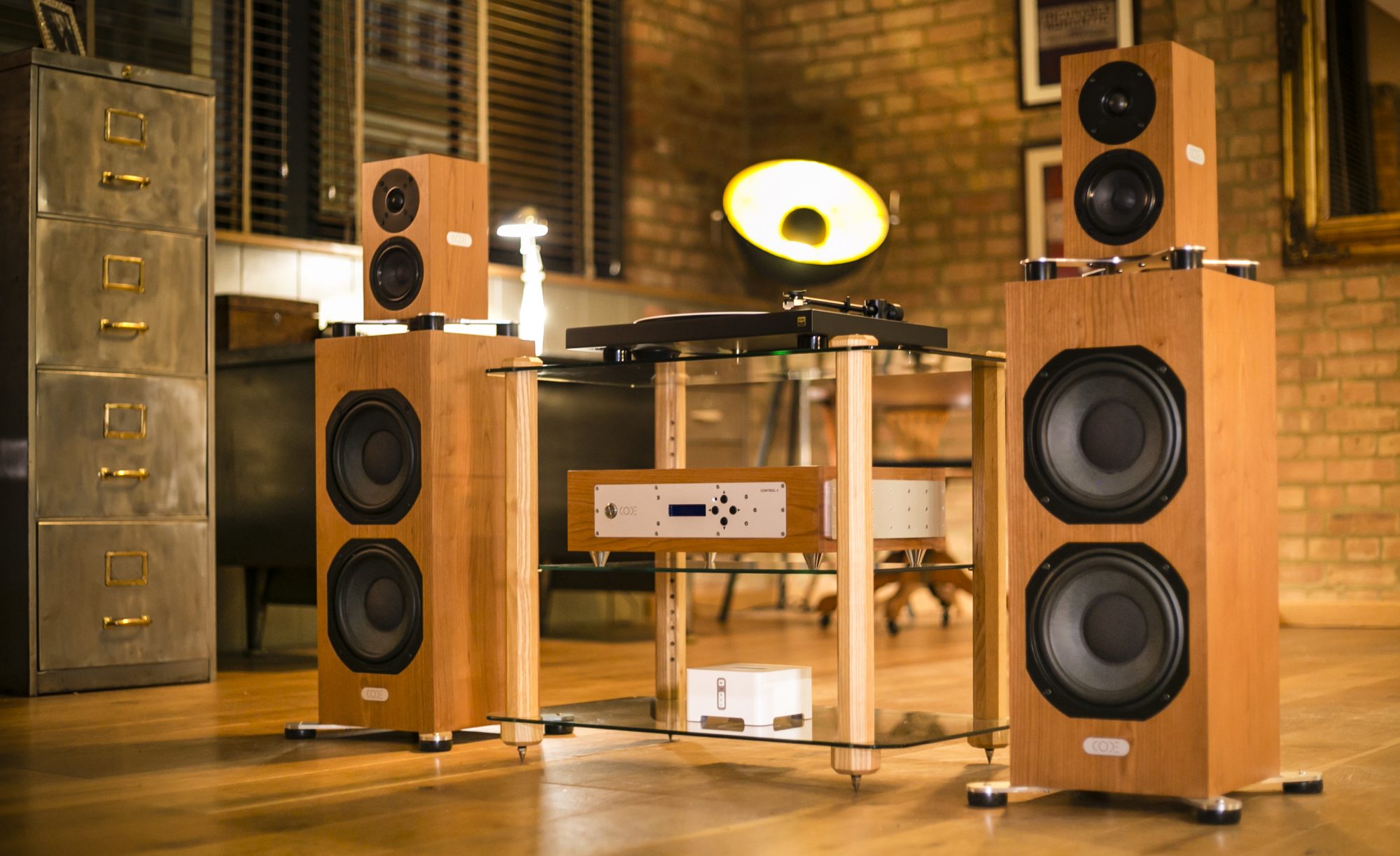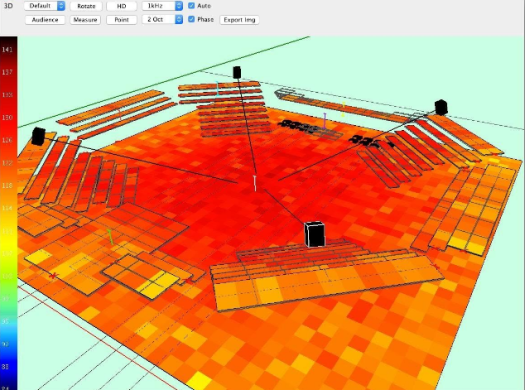Having just returned from a very enjoyable Glastonbury, experiencing some fantastic music played through good, bad and indifferent PA sound-systems, I thought it would be interesting to take a look at some of the better examples and ask the question: Could high end domestic audio learn anything from the pro industry?
Firstly I need to explain what I consider to be a good PA sound system:
- The ability to achieve high SPL, whilst crucially keeping distortion low for extended periods (the really tough bit).
- Achieve a high degree of vocal intelligibility.
- Capable of excellent transient response.
- Possess a large dynamic range.

At this point I should point out I design high end domestic speakers for the company I founded; Code Acoustics (one of our speaker systems below). We don’t make PA speakers and I’m not an FOH engineer, so there are complexities of setting up large format PA systems I don’t fully understand. I’m also aware preventing sound leakage and maintaining a standardised SPL across the listening area are important considerations.

If you’re interested our website is here:
http://www.code-acoustics.com
(or we have more articles on this blog site)
For me as a punter, when I stand in front of a PA sound system, It’s just like a big pair of domestic speakers. I ask myself; Is the sound clean, non fatiguing and natural? A sign distortion is nice and low. Can I make out the vocals and the individual instruments? A sign that there is no time related phasing issues (group delay). Do drum beats have real attack? A sign transient response and dynamic range are good. If the answer to all of the above is a resounding ‘yes’, then that’s when the magic happens. The emotion of the music comes through and you have an irresistible urge to dance (music dependent!).
With this in mind, I wandered around the festival over the 5 days. I listened to various systems and pondered (between enjoying the music and the odd cider!); what elements of these systems are better or worse than the speakers we make?
A cautionary note:
Some of the sound systems across the festival were exceptionally loud and I’m always surprised and a little concerned to see people standing next to speaker stacks or worse still, little children being pulled around in trolleys with no ear defenders on!
I would wholeheartedly recommend a good pair of custom fit ear-plugs similar to the pair below. They do adjust the hearing balance, but it’s a small price to pay not to have tinnitus!

My least favourite:
Almost all of the larger stages were equipped with what’s referred to as ‘line arrays’. This is essentially a tall column of identical speaker boxes, stacked on top of each other and hoisted into the air. These boxes (usually) reproduce the whole frequency spectrum except the low bass. This is usually below 70Hz (ish) and is reproduced by bass cabinets stacked on the floor near the stage.

Below is the Pyramid (or main stage) at Glastonbury. Note that there are actually two left and two right stacks by the stage, but also a pair of delay stacks further forward. In fact there is another pair of delay stacks further forward and just out of shot, making 8 mid/high stacks in total. Getting everything to sync must be a mighty challenge for the sound engineers!

Personally I’m not a big fan of line arrays. I find the vocal intelligibility to be poor, which I suspect is due to phasing issues between the many tweeters and mids in the stack. Probably due to this I find them a little lifeless and I just don’t get a buzz when I listen to music played through them.
I prefer a point source solution where the tweeter and mids are tightly packed together around a point. Something like the Danley Sound Labs Jericho horns (below).
I completely understand this is a contentious view and many in the PA industry who use line-arrays would strongly disagree with me (and have!). But that’s okay, and the fact sound is subjective and people have different opinions, makes the world of audio a fascinating place!
Danley Sound Labs J3-64 speaker:

http://www.danleysoundlabs.com/products/loud-speakers/jericho/j3/
My favourites:
Two of the sound systems I enjoyed the most were on the smaller stages; notably Glade and the Temple. These were provided by Function One and Danley Sound Labs respectively.
<Quick note to say I have no commercial interests with any PA companies>
I’ll also do an in depth article about these companies at a later date, as they both have interesting stories and equally interesting heads of R&D in Tony Andrews (Funktion One) and Tom Danley (Danley Sound Systems).
But for now I’ll simply cover the installations they had at Glastonbury and some of the technologies they employ.
Glade – Function One (provided by Sound Services)

System explained:
4-way design:
- Tweeter: 1.4″ horn loaded compression driver (4kHz up)
- Mid: 10″ horn loaded (plus phase plug) paper driver (200Hz to 4kHz)
- Mid bass: 15″ horn loaded paper driver (70Hz to 200Hz)
- Bass: 21″ and 31″ horn loaded paper driver (25Hz to 70Hz)
How it sounded:
The sound system was played at such a high volume during the sets, I felt I had to wear ear plugs. However, I did hear Sound Services doing a sound check on Wednesday and thought the sound was coherent and clean with a mighty scale. I do find the upper mid in Funktion One systems a fraction harsh when the systems are pushed hard and I suspect that’s due to asking a 10″ mid to go up to 4kHz.
But perhaps the best part about a Funktion One system is the upper bass. It’s just wonderfully punchy, tight and detailed. I’ve yet to witness a system that is so good at getting a crowd of people to dance, and surely that’s the highest praise you can give a PA system! I’d suggest this is also the reason most of the top nightclubs around the world have Funktion One Systems.
This was the main room at Space Ibiza (now defunct (a travesty!)), personally tuned by Tony Andrews and probably the finest PA system I’ve ever heard:

Technology / Design principles:
Paper Cone mid-range with phase-plug:
Tony Andrews has never liked metal compression drivers, finding them hash and unpleasant to listen to. So he advocates the use of a paper mid-range driver to cover almost the entire vocal range, employing their iconic ‘axehead’ phaseplug to allow the driver to reach higher frequencies than would otherwise be possible.

High Sensitivity:
Funktion One quote extremely high sensitivity for their speakers. You achieve this with drive unit utilising a very powerful motor (magnet) and very light cone. This give a great power-to-weight ratio and ergo great acceleration, the same as a car!
Below is the bass driver from our SYSTEM-1, which has the same combination of powerful magnet and light cone:

A drive unit that can accelerate quickly has great ‘transient response’. A transient is a sound that quickly comes and goes, like a drum-skin being hit. If a drive unit has a weak magnet or a heavy cone (or worse still both!), then by the time the diaphragm starts to accelerate to hit the transient, it’s already over (see below). The bass just sounds plodding and lifeless.
The diagram below is taken from the excellent paper by Tony Andrews called ‘Reality? or Soft Focus?’

Another method employed to achieve high sensitivity is the use of horns. These act as an acoustic amplifier by better coupling the drive unit to the surrounding air. An additional benefit of high sensitivity is it puts far less demand on the amplifiers, keeping its distortion levels low.
No EQ:
Another belief of Tony Andrews is that EQ is bad and produces as many problems as it solves namely time related phase issues called group delay. Funktion One go to great lengths to tune their speakers flat, even designing custom diaphragms in house for every new design. Due to this, they simply recommend 4th order L-R crossover filters between each frequency band.
Bass-horns:
Well in fact their bass speakers are not true horns, but could perhaps best described as 4th order band-pass speakers using a flared port (see below). Whether they are or aren’t horns is an academic argument. What is important is they produce a wonderfully powerful, tight punchy bass that gets people dancing.
Note: The below speaker design is the HD15 designed by Rog Mogale, but is similar in principle to the Funktion One bass horns.

No recycled energy:
Funktion one use sealed cabinets in all their top line speakers. They’ve recently released a range of ported bass speakers for where the audience are very close to the speakers (primarily in smaller nightclubs). However, if it’s a top of the range system and the room is large enough Funktion One will always spec a fully sealed horn loaded system. This sacrifices some low end extension and a small amount of sensitivity, but it reduces the risk of time related phase issues (group delay), which can smear transients among other things.

Big drivers:
Below is Funktion One’s F132 horn cabinet, which utilises a Powersoft’s 10k linear motor connected to a custom 32″ diaphragm. I guess it’s fair to say that they also believe that if you want good bass, you need to move a lot of air (as gently as possible)!

To give you an idea of how big a 32″ driver is, it’s big(!):

The Powersoft motor is particularly interesting as almost every other drive unit used in the PA industry, and most of the hifi industry use a wound metal coil (electro-magnet) sat within a permanent magnet to move the diaphragm. This solution is great for small cone movements, but not so good for large movements, particularly over a long duration. This causes the ‘voice-coil’ to become extremely hot where its behaviour starts to change. This causes a distortion specifically known as power compression.
The Temple – Danley Sound Systems (provided by Neuron Pro Audio)
http://www.danleysoundlabs.com/
http://www.neuronproaudio.co.uk/

System explained:
4-way design:
- Tweeter: 1.4″ synergy horn loaded compression drivers
- Mid: 6.5″ synergy horn loaded paper drivers
- Mid bass: 12″ synergy horn loaded paper driver, crossed at 70Hz
- Low Bass: 18″ tapped horn loaded paper driver
Neuron were using a 4 point Jericho (PG-J94) configuration as you can see in the image above. Then with a small stack of tapped horn bass enclosures left and right of the stage, and another small stack at the rear of the venue (see below). A pair of SH-96’s were also used as fills left and right of the stage.

How it sounded:
This sound system was physically smaller than the Funktion One system and seemed to be at a lower SPL (not necessarily a bad thing!). I was initially surprised at quite how few speaker boxes were making such a large amount of sound. I listened very briefly to the beginning of the ‘Stanton Warriors’ set without ear plugs, before putting them in.
The first thing that grabbed me was how exceptionally clean the bass was. Super smooth and it just seemed to physically envelop you. It perhaps wasn’t as punchy as the Funktion One system, but in its own way was every bit as good.
I can’t really make a detailed evaluation of the mid/highs due to the short time I listened without ear-plugs and the fact it was a bass heavy set without a great deal of vocal content. However, from what I heard there seemed to be remarkably little distortion and the sound was highly coherent. I will en-devour to track down a Danley system and provide more detailed thoughts when I do.

Technology / Design principles:
Synergy Horn:
The synergy horn is a very clever concept. It essentially allows a number of drive units to use the same horn. It’s an extremely compact solution, but also has the benefit of maintaining good phase behaviour and hence low distortion.

I’ve yet to build a synergy horn, but apparently one important factor is to keep the holes fairly small to ensure the other drivers just ‘see’ a smooth uninterrupted horn.
Neuron Pro Sound used a combination of SH96 and Jericho cabinets for all but hte low bass frequencies on the Temple stage. The SH96 can be seen below:

One advantage of this type of cabinet is rather than using one relatively large diameter midrange (Funktion One use a 10″), you can use a number of smaller diameter units that have a higher breakup frequency. Here Danley utilises six 4″ drivers. These drivers are sealed backed meaning the whole cavity behind the horn can be put to use by the four 15″ mid/bass drivers.
It’s beyond the scope of this article to go into detail about Danley’s technologies, but I strongly suggest you have a look at his white paper here:
Click to access The-Tapped-Horn.pdf
Tapped Horn:
The bass speakers used at the Temple stage were the Danley TH-118’s as shown below:

At first it’s a little confusing as to what is going on. Is it sealed, ported, a horn or some sort of hybrid?
The diagram below shows the tapped horn principle. It’s a horn with the drive unit firing into the throat of the horn (as is the convention), but the interesting thing is that the back side of the driver fires into the mouth of the horn.
The tapped horn design below is a DIY project, but from what I understand it’s similar in concept to the Danley tapped horns:

There is the obvious advantage that you are getting double the output, but also that cabinet resonance will be pretty low as the air flows relatively freely through the cabinet.
Another major plus for PA is that the driver is mounted in free air with a high degree of air flow. This is very different from conventional sealed horn speakers where the driver sits in a small sealed cavity. In this situation the air in the chamber can heat up extremely quickly. With no cold air to cool the voice coil, its temperature will also rise quickly and your get significant power compression. In contrast the tapped horn keeps its drivers voice coil nice and cool, meaning it can play loudly, for extended periods without distorting.
The tricky bit is getting the back side of the driver at exactly the right distance in the horn to ensure good phase behaviour. Again I haven’t really got time to cover this subject here, but the article below is well worth a read:
http://www.cowanaudio.com/th.html
To be continued!
To avoid making this article overly long, we’ll stop here, but pick the story back up in part 2 with a look at how similar PA and Hifi speakers are, and what principles translate particularly well.
Thanks for reading!
Ceri




Did you listen to the other stage?
LikeLike
Hi Tom, thanks for the message. Only in passing. From memory it was a line-array like all the big stages at Glasto, though on a smaller scale to the Pyamid stage. No delay stacks for instance, just LH and RH. I thought it sounded okay, but that’s about all I could say.
LikeLike
I heard many people saying the Glade stage was the best sound on site.
Good comments about the Danley too.
Worth considering that the Martin Audio MLA on the Pyramid Stage is absolutely full of DSP, on every driver in fact. Quite the opposite approach to Funktion One.
Interesting that not everyone seems to like how it sounds.
LikeLike
Hi David, thanks for this, really interesting 🙂 I’m intrigued to understand exactly what DSP they’re applying and what they’re trying to achieve with it. We use DSP on our domestic speakers, but aim to use ‘just enough’. I do fully appreciate there is a lot more going on with a very large PA rig using multiple line arrays and trying not to minimize sound leakage. I just think that a point source such as Danley Sound Labs Jericho horns give you a better chance of a high quality sound, but that’s just my opinion.
LikeLike
Maybe you should ask Martin audio to comment but essentially MLA isnt just about DSP it is way deeper and being emulated by many others. Real time Manipulation of phase and amplitude relationships between individual drivers in conjunction with highly sophisticated prediction and control software to enable higher audience intelligibility and SPL and improvement in smooth coverage for the entire audience plane together with lower off site noise. Line array isn’t wrong and point source isn’t right they are two different ways of achieveing great sound for large audiences and in fact most large scale PA systems like Funktion One are arrays just horizontal and linear rather than just linear. In many ways point source is the ideal as that is how sounds originate but it is sometimes difficult to scale up.
LikeLike
Thanks for sharing your thoughts Kevin, that’s a really well considered argument.
LikeLike
There’s a set of videos on YouTube explaining the Martin MLA philosophies that make interesting viewing
LikeLike
Interesting read, thanks! I was at the Glade on Thursday this year on the Thursday during the afternoon ‘Funktion One Experimental Soundfield’ session and I have to say it sounded stunning. They were playing 12″ extended disco records and I’ve never heard A Taste Of Honey “Boogie Oogie Oogie” sound so good or with such clarity before. All frequencies across the board sounding pin sharp. Did I hear correctly that the people behind the Glade sound system were somehow involved in the sound system at the first every Glastonbury? Unfortunately West Holts had terrible sound on Friday and Saturday and previous years I’ve always found the sound there rather good. This year I had real trouble finding somewhere where I could hear the vocals clearly and it didn’t sound muddy. It was rather windy though, maybe a delay stack would have helped?
LikeLike
Hi Joel, Great, I’m glad you enjoyed it! Also, a big thanks for posting a comment that isn’t related to line-array’s 🙂 Yeah, the experimental sound field deserves a bit of coverage in it’s own right, as it’s nice to see people doing something a little different. My understanding is it’s Tony Andrews’ (head of R&D at Funktion One) pet project. I did see pics of him setting up the system with Sound Services prior to the festival. I also read something saying Tony Andrews had something to do with the sound system at the first Glasto, but don’t know the full story.
I do love Glade as a venue. It’s got that cool indoors outdoors feel about it and the trees all around make a great setting.
LikeLike
Thanks for a perfectly described review.
It’s quite different to read and appreciate every word when someone who really knows .
You did go to the exact infomation as a true audiophile and connosieur.
I do love F1.
I also agree 100% on F1’s apprach in splitting frequencies and components for each Band. All work relatevely effortless in his approach.
Keep bringing this quality of reviews and notes please!
LikeLike